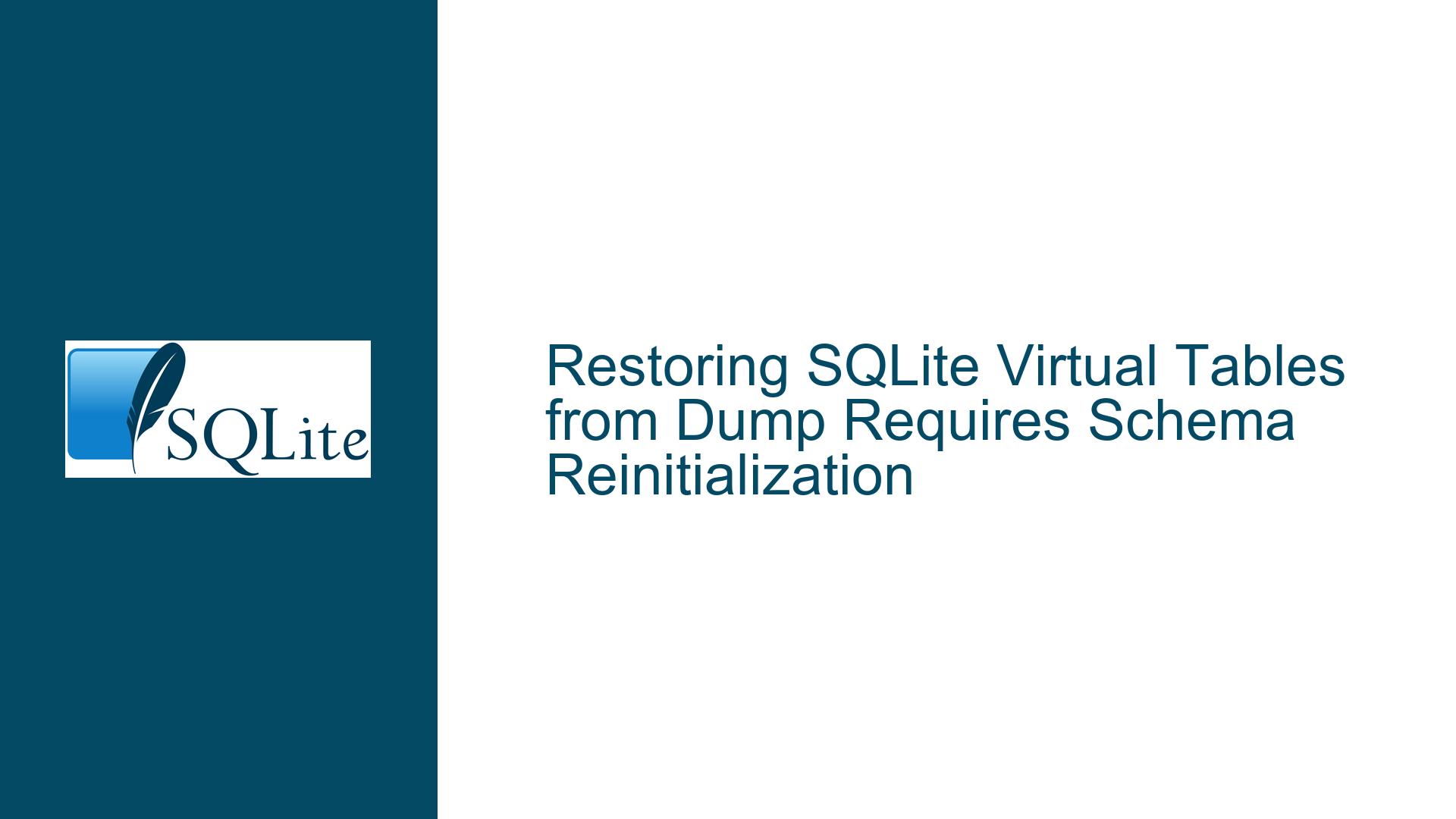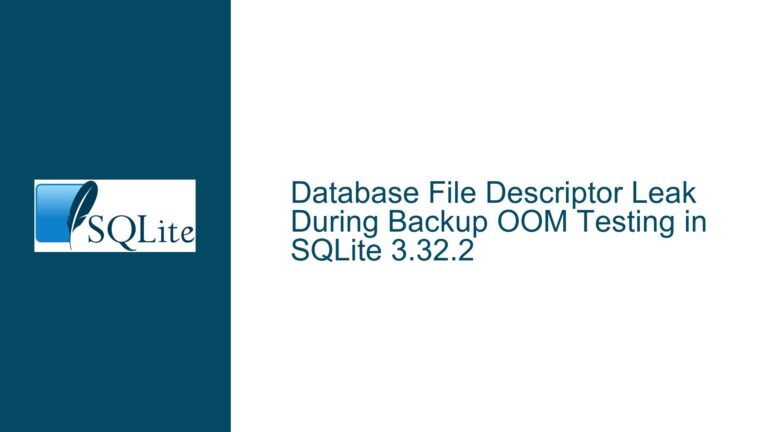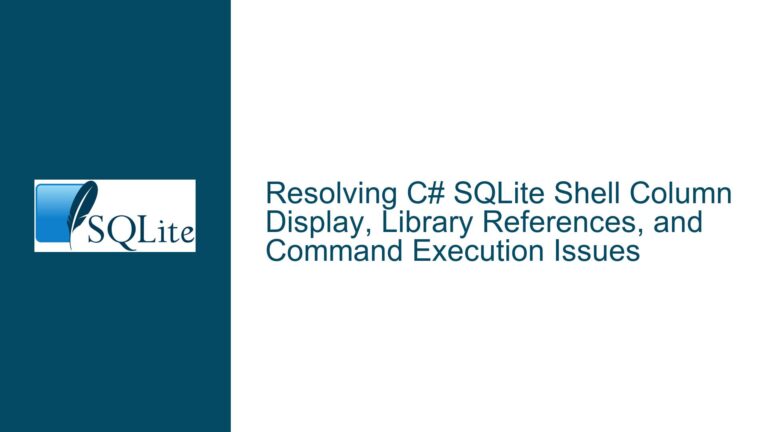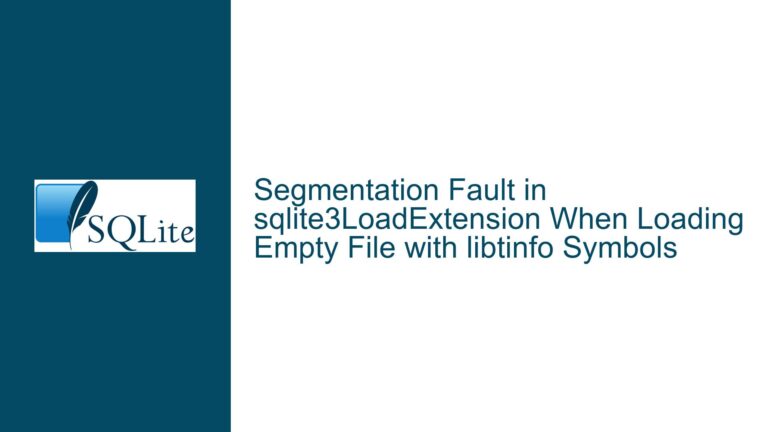Restoring SQLite Virtual Tables from Dump Requires Schema Reinitialization
Virtual Table Registration Failure After .dump Restoration
Issue Overview: Schema Insertion Bypasses Virtual Table Initialization
When utilizing the SQLite command-line interface (CLI) .dump command to back up databases containing virtual tables (e.g., FTS5), the restoration process may leave these tables in an unusable state until the database connection is closed and reopened. This occurs because the .dump command serializes virtual tables as direct INSERT statements into the sqlite_schema system table rather than emitting the original CREATE VIRTUAL TABLE command.
Virtual tables in SQLite depend on runtime registration by their associated modules (e.g., FTS5). This registration process is triggered when a CREATE VIRTUAL TABLE statement is executed or when the schema cache is reloaded. Direct manipulation of sqlite_schema via INSERT statements (as done in the .dump output) does not automatically invoke this registration mechanism. Consequently, the virtual table remains "invisible" to SQLite’s query planner and execution engine until the schema cache is forcibly refreshed. For file-based databases, closing and reopening the connection achieves this refresh implicitly. However, in-memory databases pose a unique challenge: closing the connection destroys the database, making this workaround impractical.
The problem is exacerbated by the CLI’s default behavior of emitting PRAGMA writable_schema=OFF after modifying sqlite_schema during restoration. This pragma disables further direct writes to the schema but does not trigger a schema cache reload. The absence of cache reloading leaves the virtual table definitions inactive, rendering queries against them impossible until manual intervention.
Root Causes: Schema Cache Invalidation and Module Registration Mechanics
Direct Schema Manipulation Without Cache Reloading
SQLite maintains an internal cache of schema objects (tables, indices, triggers) to optimize query planning and execution. This cache is populated during database connection initialization or when a schema-altering statement (e.g.,CREATE,ALTER) is executed. DirectINSERToperations intosqlite_schemabypass the schema cache update mechanism. Virtual tables, which rely on module-specific initialization logic, are particularly affected because their registration requires explicit interaction with the module API. TheCREATE VIRTUAL TABLEstatement indirectly invokes this API, whereas directINSERTintosqlite_schemadoes not.Incomplete Schema Reinitialization in Dump Scripts
The.dumpcommand generates a script that includesPRAGMA writable_schema=ONto enable direct modification ofsqlite_schema, followed byINSERTstatements to recreate schema entries. However, the script concludes withPRAGMA writable_schema=OFF, which merely restores write protection on the schema without invalidating the schema cache. This leaves the database in a state where virtual table definitions exist insqlite_schemabut are not registered with their respective modules.In-Memory Database Transience
For in-memory databases (identified by the:memory:URI), the act of closing and reopening the connection is not a viable workaround because it results in the complete destruction of the database. Unlike file-based databases, where the physical file persists across connections, in-memory databases exist only for the duration of a single connection. Thus, any solution requiring connection cycling to reload the schema cache is inherently incompatible with in-memory use cases.
Resolution Strategy: Forced Schema Cache Reload and Script Modification
Step 1: Manual Schema Cache Reload via PRAGMA
After restoring the dump script, execute PRAGMA writable_schema=RESET instead of PRAGMA writable_schema=OFF. The RESET keyword performs two actions: it disables direct schema writes (equivalent to OFF) and forcibly reloads the schema cache. This reload process parses all entries in sqlite_schema, including those for virtual tables, and invokes the appropriate module registration routines.
Example Modified Dump Script:
--- Original .dump output
PRAGMA foreign_keys=OFF;
BEGIN TRANSACTION;
PRAGMA writable_schema=ON;
INSERT INTO sqlite_schema(type,name,tbl_name,rootpage,sql)VALUES('table','haystack','haystack',0,'CREATE VIRTUAL TABLE haystack using fts5(needle)');
... -- Other tables and data
PRAGMA writable_schema=RESET; -- Modified from OFF to RESET
COMMIT;
--- Subsequent queries can now access the virtual table
SELECT * FROM haystack;
Step 2: Automated Script Adjustment for Dump Output
To avoid manual editing of dump scripts, post-process the .dump output to replace PRAGMA writable_schema=OFF with PRAGMA writable_schema=RESET. This can be achieved using text processing tools like sed or integrated into custom backup scripts.
Example using sed:
sqlite3 input.db .dump | sed 's/writable_schema=OFF/writable_schema=RESET/' | sqlite3 output.db
Step 3: Alternative Backup Methods for Virtual Tables
For databases heavily reliant on virtual tables, supplement the .dump command with explicit CREATE VIRTUAL TABLE statements extracted via .schema. This ensures that virtual tables are recreated through standard DDL commands, triggering proper module registration.
Example Workflow:
- Dump the schema without data:
sqlite3 input.db ".schema --indent" > schema.sql - Dump the data, excluding virtual table schema entries:
sqlite3 input.db ".dump --data-only" > data.sql - Restore by executing
schema.sqlfollowed bydata.sql.
Step 4: Programmatic Handling for In-Memory Databases
When working with in-memory databases, design application logic to execute PRAGMA writable_schema=RESET immediately after restoring from a dump. This must occur within the same connection to prevent database annihilation.
Python Example:
import sqlite3
# Restore in-memory database from dump
conn = sqlite3.connect(':memory:')
dump_script = '''
PRAGMA foreign_keys=OFF;
BEGIN TRANSACTION;
PRAGMA writable_schema=ON;
INSERT INTO sqlite_schema(type,name,tbl_name,rootpage,sql)VALUES('table','haystack','haystack',0,'CREATE VIRTUAL TABLE haystack using fts5(needle)');
...
PRAGMA writable_schema=RESET;
COMMIT;
'''
conn.executescript(dump_script)
# Verify virtual table accessibility
cursor = conn.execute("SELECT * FROM haystack")
print(cursor.fetchall())
Step 5: Advocacy for CLI Tool Enhancement
Submit a feature request or patch to the SQLite team suggesting that the .dump command emit PRAGMA writable_schema=RESET instead of PRAGMA writable_schema=OFF when virtual tables are present. This would automate the schema cache reload process, aligning the behavior of virtual table restoration with user expectations.
Conclusion: Ensuring Robust Virtual Table Persistence
The interplay between SQLite’s schema cache, virtual table modules, and the CLI’s dump/restore mechanics necessitates deliberate handling of schema reloading. By substituting PRAGMA writable_schema=RESET in dump scripts or adopting alternative backup methodologies, developers can ensure seamless restoration of virtual tables across both file-based and in-memory databases. This approach not only resolves the immediate "no such table" error but also reinforces the reliability of SQLite-based applications leveraging virtual tables for advanced features like full-text search.






